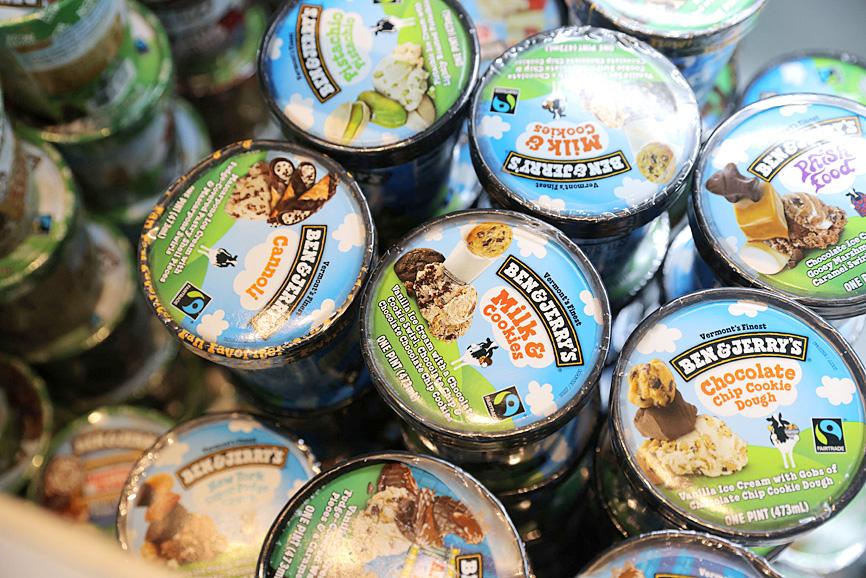Unilever PLC’s sales report showed that most shoppers are willing to pay more for products like Dove soap and Axe deodorant, but the company warned that might change as the war in Ukraine exacerbates raw material inflation.
First-quarter sales growth was 7.3 percent on an underlying basis, Unilever said yesterday, with full-year sales growth at the top end of its 4.5 to 6.5 percent forecast.
However, Unilever said that profitability would probably be at the bottom end of its forecast range this year, as shoppers start to balk at new price increases.

Photo: Reuters
Unilever is one of the few major European consumer goods companies that have been reporting a decline in shipments, even though the drop was less than expected in the first quarter.
Nestle SA has said it does not yet see signs of shoppers switching to cheaper products.
“There is more to do as we navigate our business through unprecedented cost inflation, but we are making good progress,” chief executive officer Alan Jope said in the statement.
Unilever boosted pricing almost 13 percent on homecare products, which include Omo detergent and Domestos cleaners, resulting in a 2.9 percent drop in volume.
The maker of Ben & Jerry’s ice cream and Dove soap earlier this year said that it was facing the worst inflation since the financial crisis and that it would take two years for the company to return to last year’s profitability level.
“It’s extremely hard to predict where we end up” on inflation in the near term, chief financial officer Graeme Pitkethly said on a call with reporters.
“We still expect to restore our margins in 2023 and 2024, but we’re seeing about 6 billion euros [US$6.3 billion] of costs increases since last year and that’s quite extraordinary for us,” he added.
Unilever expects raw material cost inflation of 2.7 billion euros in the second half, up from 2.1 billion euros in the first half.

Zhang Yazhou was sitting in the passenger seat of her Tesla Model 3 when she said she heard her father’s panicked voice: The brakes do not work. Approaching a red light, her father swerved around two cars before plowing into a sport utility vehicle and a sedan, and crashing into a large concrete barrier. Stunned, Zhang gazed at the deflating airbag in front of her. She could never have imagined what was to come: Tesla Inc sued her for defamation for complaining publicly about the vehicles brakes — and won. A Chinese court ordered Zhang to pay more than US$23,000 in

Taiwan Semiconductor Manufacturing Co (TSMC, 台積電) yesterday said that its investment plan in Arizona is going according to schedule, following a local media report claiming that the company is planning to break ground on its third wafer fab in the US in June. In a statement, TSMC said it does not comment on market speculation, but that its investments in Arizona are proceeding well. TSMC is investing more than US$65 billion in Arizona to build three advanced wafer fabs. The first one has started production using the 4-nanometer (nm) process, while the second one would start mass production using the

US President Donald Trump has threatened to impose up to 100 percent tariffs on Taiwan’s semiconductor exports to the US to encourage chip manufacturers to move their production facilities to the US, but experts are questioning his strategy, warning it could harm industries on both sides. “I’m very confused and surprised that the Trump administration would try and do this,” Bob O’Donnell, chief analyst and founder of TECHnalysis Research in California, said in an interview with the Central News Agency on Wednesday. “It seems to reflect the fact that they don’t understand how the semiconductor industry really works,” O’Donnell said. Economic sanctions would

‘NO DISRUPTION’: A US trade association said that it was ready to work with the US administration to streamline the program’s requirements and achieve shared goals The White House is seeking to renegotiate US CHIPS and Science Act awards and has signaled delays to some upcoming semiconductor disbursements, two sources familiar with the matter told reporters. The people, along with a third source, said that the new US administration is reviewing the projects awarded under the 2022 law, meant to boost US domestic semiconductor output with US$39 billion in subsidies. Washington plans to renegotiate some of the deals after assessing and changing current requirements, the sources said. The extent of the possible changes and how they would affect agreements already finalized was not immediately clear. It was not known